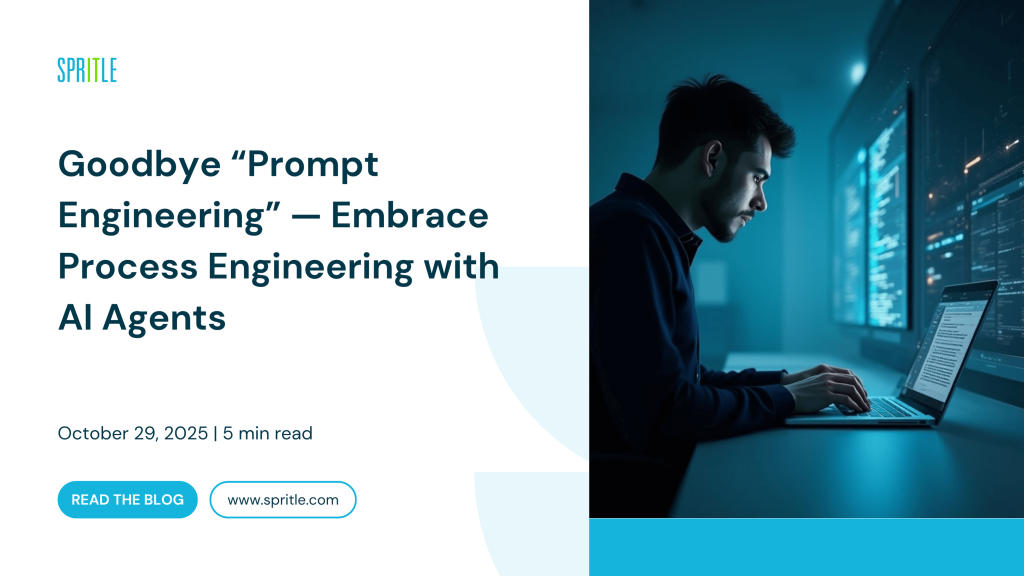
A year ago, prompt engineering was the hottest buzzword in AI. Everyone was talking about the art of crafting the “perfect prompt” to get the most out of large language models (LLMs). Entire courses, communities, and job postings emerged around it.
But AI doesn’t stand still. Models have improved, businesses demand more, and the simple trick of wording things just right is no longer enough. We’re moving into a new era: process engineering with AI agents.
This shift isn’t just technical — it’s strategic. It changes how companies think about automation, how teams design workflows, and even what skills the workforce needs. Let’s explore why prompt engineering is fading, what process engineering brings to the table, and how this transition will shape the future of AI.
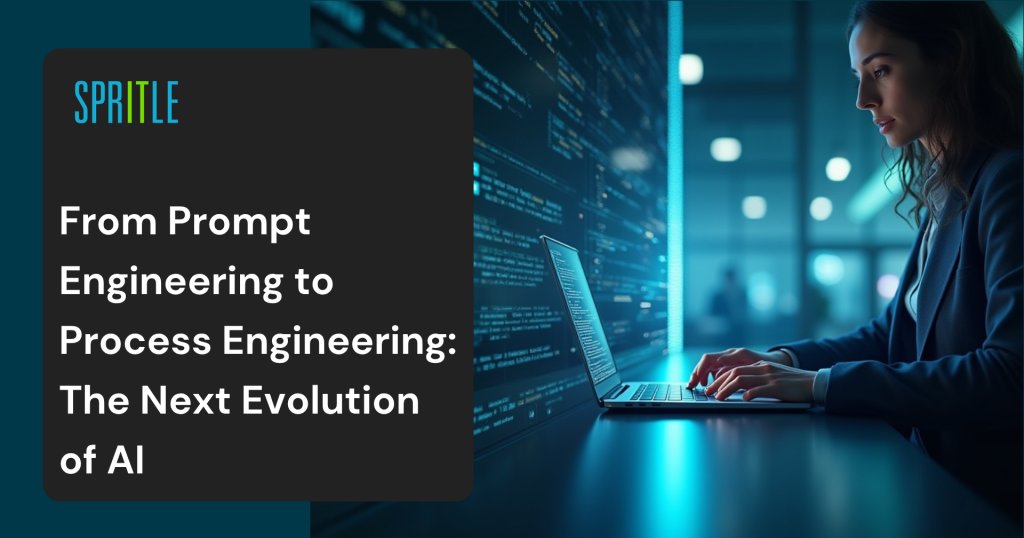
Why Prompt Engineering Had Its Moment
When GPT-3 and GPT-4 burst onto the scene, it quickly became clear that how you asked a question determined what you got back.
For example:
- Vague prompt: “Explain AI in healthcare.”
→ Output: A generic overview. - Engineered prompt: “Write a 600-word article for healthcare professionals explaining how AI improves early cancer diagnosis, including case studies and ethical concerns.”
→ Output: Focused, relevant, and actionable content.
Prompt engineering gave people a kind of superpower. By tweaking wording, adding roles, or using examples, they could unlock dramatically better outputs. Techniques like few-shot prompting, chain-of-thought reasoning, and role assignments became the toolkit of early adopters.
For a while, this worked brilliantly. But cracks soon appeared.
Why Prompt Engineering Alone Isn’t Enough
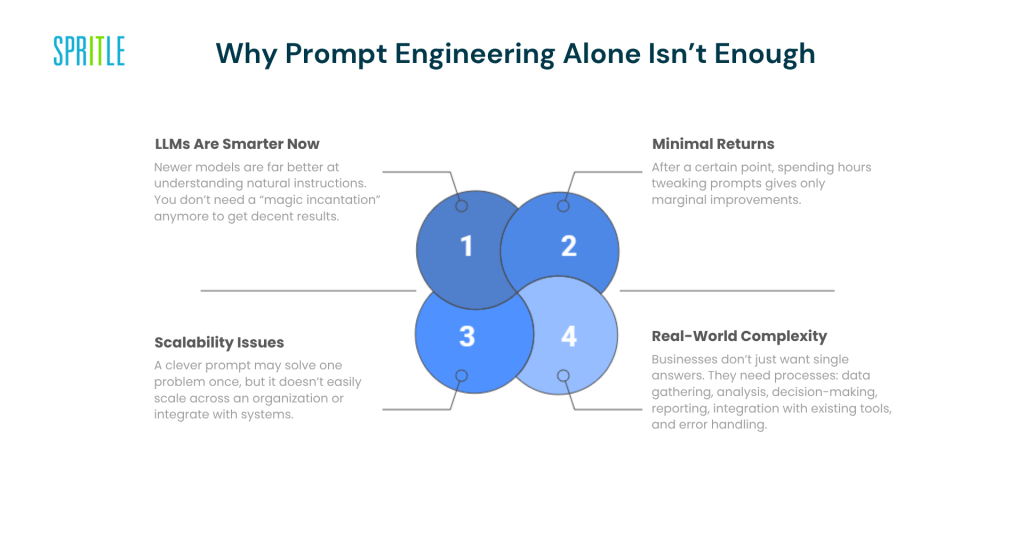
There are four main reasons prompt engineering is losing its shine:
- LLMs Are Smarter Now
Newer models are far better at understanding natural instructions. You don’t need a “magic incantation” anymore to get decent results. - Minimal Returns
After a certain point, spending hours tweaking prompts gives only marginal improvements. - Scalability Issues
A clever prompt may solve one problem once, but it doesn’t easily scale across an organization or integrate with systems. - Real-World Complexity
Businesses don’t just want single answers. They need processes: data gathering, analysis, decision-making, reporting, integration with existing tools, and error handling.
That’s where process engineering with AI agents comes in.
From Prompts to Processes
Think of prompt engineering as giving directions to a GPS: “Take me to the airport.”
- If you phrase it well, you’ll get a decent route.
- If not, you might get stuck in traffic.
Now imagine process engineering: instead of just asking for directions, you have a self-driving car (the AI agent). You tell it the goal, and it figures out the route, adapts to traffic, refuels if needed, and even drops you off at the right terminal.
That’s the difference: prompts tell, processes orchestrate.
Prompt vs. Process: The Key Differences
| Aspect | Prompt Engineering | Process Engineering with AI Agents |
| Focus | The wording of a single request | Designing end-to-end workflows |
| Tools | LLM only | LLM + APIs, databases, apps |
| Scope | One-off task | Multi-step, repeatable tasks |
| Control | Human must manually refine | Agent self-manages within guardrails |
| Scalability | Difficult to reuse | Easily automated and replicated |
| Example | “Summarize this PDF in 300 words.” | Agent fetches PDFs, summarizes them, compares themes, generates a dashboard, and emails results. |
Examples in Action : Prompt Engineering Vs Process Engineering
Market Research
- Prompt approach: “Summarize key U.S. telemedicine trends in 2023.” → A 500-word text summary.
- Process approach: Agent searches industry sites, extracts reports, cross-checks with government data, builds a chart of growth projections, and sends both PDF + PPT to your team.
Healthcare Intake
- Prompt approach: “Act like a nurse and ask intake questions for a flu patient.” → A basic text conversation.
- Process approach: Agent asks questions, stores answers in the clinic’s EHR, checks vaccination records, suggests diagnoses, and books follow-ups automatically.
The leap from “answer provider” to “workflow partner” is massive.
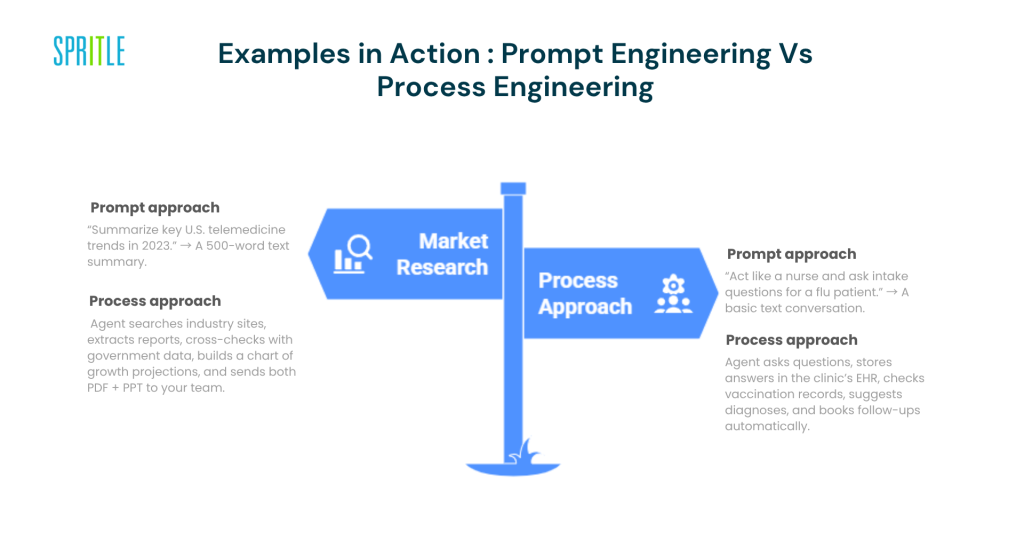
Why Process Engineering Matters
- Scalability — Businesses need reliable systems, not one-off clever tricks.
- Reliability — Agents can monitor themselves, reducing human error.
- Integration — AI can now talk to CRMs, ERPs, and healthcare systems.
- New Roles — “Prompt engineer” is evolving into workflow designer, agent orchestrator, and AI operations lead.
- Innovation — Freed from repetitive tasks, humans can focus on strategy, creativity, and empathy.
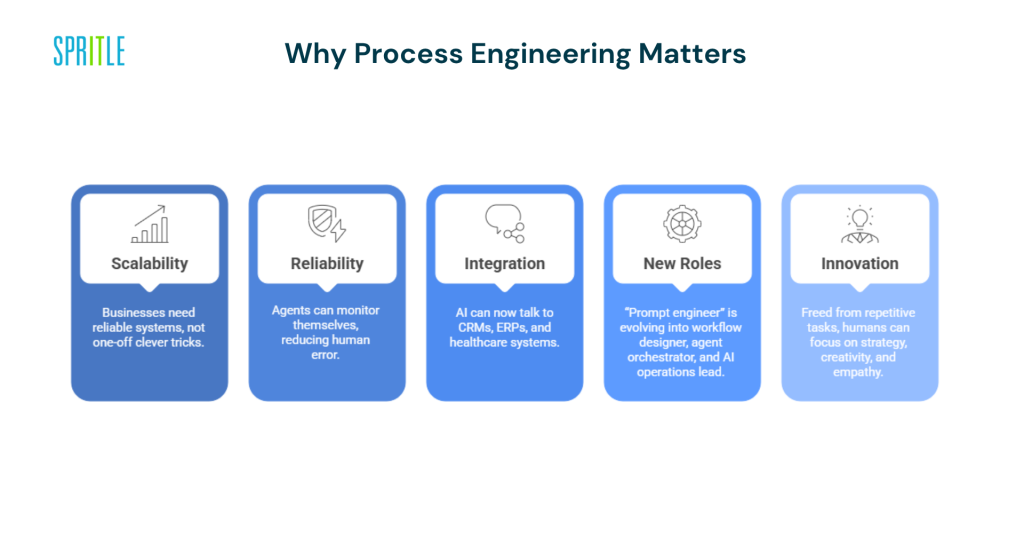
Real-World Use Cases
- Healthcare: Agents that match patients to clinical trials by scanning databases, checking eligibility, and producing reports.
- Finance: Agents that flag fraud by monitoring transactions, running risk checks, and escalating cases.
- Education: AI tutors that assess progress, design lesson plans, and notify teachers when intervention is needed.
- Customer Service: Omnichannel agents that resolve tickets, pull CRM data, and escalate to humans when necessary.
The Challenges Ahead in Process engineering
Of course, building processes is harder than writing prompts. Organizations must handle:
- Complexity of designing multi-agent workflows.
- Risk of autonomy — agents can go off track.
- Compliance in regulated industries.
- Cost of infrastructure.
- Trust — users need transparency and oversight.
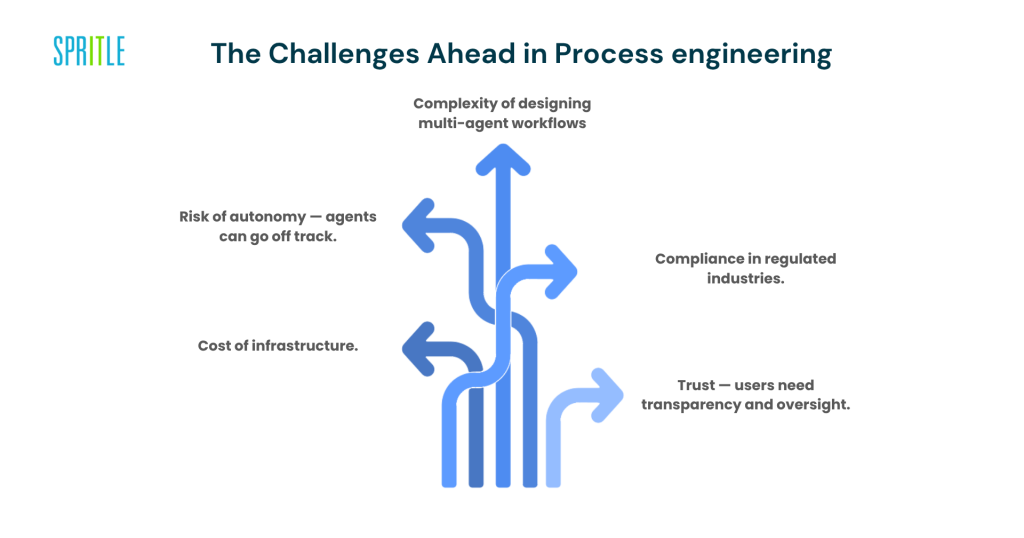
The Future: Hybrid Human + Agent Teams
The most successful companies won’t replace humans with AI. They’ll design hybrid teams where:
- Humans provide empathy, judgment, and strategy.
- Agents provide speed, consistency, and scale.
It’s the same evolution we saw when businesses first adopted computers: from tools, to workflows, to indispensable partners.
Skills You’ll Need in This Era
- Workflow design — mapping out business processes.
- Systems integration — connecting agents to APIs and databases.
- Agent orchestration — coordinating multi-agent collaboration.
- Monitoring & evaluation — dashboards, metrics, and human feedback loops.
- Ethics & compliance — ensuring responsible AI use.
Change management — helping teams adapt to AI-driven workflows.
Closing Thoughts
“Goodbye prompt engineering — hello process engineering with AI agents” isn’t just a catchy line. It captures the moment we’re in: moving from clever one-liners to sophisticated systems that transform industries.
Just like the internet evolved from static pages to dynamic applications, AI is evolving from prompts to processes. Those who learn to design, manage, and scale AI-driven workflows will lead the future.
The question for you is: Are you still writing prompts, or are you ready to design processes?
